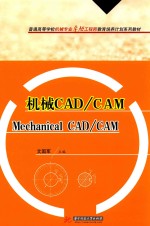

机械CAD/CAM 英文PDF电子书下载
- 电子书积分:9 积分如何计算积分?
- 作 者:文国军主编
- 出 版 社:武汉:华中科技大学出版社
- 出版年份:2015
- ISBN:9787568001106
- 页数:167 页
Chapter 1 Introduction to CAD/CAM 1
1.1 Historical Perspective of CAD/CAM 1
1.2 Benefit of CAD/CAM 3
1.2.1 Increased Productivitv 3
1.2.2 Better Quality 3
1.2.3 Better Communication 3
1.2.4 Common Database 3
1.2.5 Reduced Prototype Costs 4
1.2.6 Faster Response to Customers 4
1.3 CAD/CAM Database 4
1.4 CAD/CAM Selection Criteria 5
1.5 Application of CAD/CAM 6
1.5.1 Aerospace Industry 6
1.5.2 Automotive Industry 7
1.5.3 General Industry 8
Chapter 2 Computer Hardware of CAD/CAM System 9
2.1 Computer System Classification of CAD/CAM 9
2.1.1 Mainframe Computer Platforms 9
2.1.2 Engineering Workstation Platforms 10
2.1.3 Microcomputer Platforms 10
2.2 Computer Hardware Basic Operation 11
2.3 Typical Computer Hardware Configuration of CAD/CAM 13
Chapter 3 Geometric Transformations 15
3.1 Definition of Geometric Transformation 16
3.2 Transformation of a Point 17
3.3 Generic Transformation 17
3.3.1 Translation 17
3.3.2 Scaling 18
3.3.3 Reflection 19
3.3.4 Rotation 20
3.3.5 Shear 21
3.4 Complex Transformation 22
3.4.1 Concatenated Transformations 22
3.4.2 Homogeneous Representation 22
3.4.3 Geometric Transformation for Three View Drawing 23
3.5 Perspective Projection Transformation 25
3.5.1 Principle of Perspective Projection Transformation 26
3.5.2 Classification of Perspective Projection Transformation 27
Chapter 4 CAD/CAM Modeling Technology 29
4.1 Functions of ICG Technology 29
4.1.1 Input Functions 29
4.1.2 Producing Graphic Images 30
4.1.3 Manipulation of Graphic Images 30
4.1.4 Terminal Display Control 30
4.1.5 Editing Functions 30
4.2 Basic Operation of CAD/CAM Modeling Software 30
4.3 Modeling System Classification 32
4.3.1 CAD 2D Wireframe Systems 33
4.3.2 CAD 3D Wireframe Systems 34
4.3.3 Surface Model Systems 35
4.3.4 Solid Model Systems 36
4.4 Parametric Modeling 40
4.4.1 Profile 41
4.4.2 Dimension drive 41
4.4.3 Variable Drive 42
4.4.4 Constraint-Based 42
4.4.5 Rationality Checking 43
4.4.6 Dynamic Navigator 43
4.4.7 Feature-Based Modeling 43
4.5 SolidWorks Modeling Software 44
4.5.1 Concepts 44
4.5.2 Terminology 45
4.5.3 User Interface 46
4.5.4 Design Process 51
4.5.5 Design Intent 52
4.5.6 Design Method 52
Chapter 5 Reverse Engineering 62
5.1 Basic Phases of Reverse Engineering 62
5.2 Data Capture Methods 64
5.3 Data Capture Devices 66
5.3.1 3D Digitizer 66
5.3.2 Coordinate Measuring Machine 67
5.3.3 3D Laser Scanners 67
5.3.4 Structured-Light 3D Scanners:3D Optical Imager 68
Chapter 6 Parametric Programming 69
6.1 Principle of Parametric Programming 69
6.2 Visual LISP-Based Parametric Programming for AutoCAD 69
6.2.1 What Visual LISP Offers 70
6.2.2 Starting Visual LISP 71
6.2.3 Exploring the Visual LISP User Interface 71
6.2.4 Loading and Running AutoLISP Programs 72
6.2.5 VLISP Programming Demonstrations 73
6.3 VBA-Based Parametric Programming for AutoCAD 78
6.3.1 How VBA Differs from AutoLISP 79
6.3.2 Visual Basic versus Visual Basic for Applications 80
6.3.3 The AutoCAD VBA Environment 80
6.3.4 VBA Programming Demonstrations 81
6.3.5 VBA Advanced Programming Demonstration 83
6.4 ObjectARX-based Parametric Programming for AutoCAD 91
6.4.1 ObjectARX Overview 91
6.4.2 “Hello,World!”Program 94
6.4.3 Some Useful Functions 98
Chapter 7 Computer Aided Engineering 101
7.1 Finite Element Analysis 102
7.2 Virtual Prototyping 102
7.3 CAE Softwares 103
7.3.1 ANSYS 103
7.3.2 SolidWorks Simulation 103
7.3.3 ADAMS 104
7.4 Projects of CAE Software Application 105
7.4.1 Stress Analysis and Optimization of Gear Teeth for Crown Gear Based on Limited Length Contact Theory in ANSYS Environment 105
7.4.2 Kinematics Simulation to Manipulator of Welding Robot Based on ADAMS 110
Chapter 8 Virtual Reality 116
8.1 Features of Virtual Reality Systems 116
8.1.1 Virtual Reality Immersion 117
8.1.2 Virtual Reality Ambience and Atmosphere 117
8.2 Interactive Devices for Virtual Reality 118
8.2.1 Head-Mounted Display 118
8.2.2 Data Glove 119
8.2.3 Data Suit/Clothing 119
8.2.4 Joysticks 120
8.3 VR-Based Training System Development for HDD Rig 120
8.3.1 Development of Software Part 121
8.3.2 Development of Hardware Part 123
Chapter 9 Advanced CAM Technology 126
9.1 Computer Numerical Contro1 126
9.2 Directed Numerical Control 127
9.3 Distributed Numerical Control 127
9.4 Group Technology 128
9.5 Flexible Manufacturing 129
9.6 Rapid Prototyping and Manufacturing 129
9.7 Computer-Aided Process Planning 130
9.8 Computer-Aided Production Management 131
9.9 Virtual Manufacturing 132
9.10 Application of CAM Software:SolidCAM 133
9.10.1 Introduction to SolidCAM 133
9.10.2 Basic Concepts 134
9.10.3 Process Overview 134
9.10.4 Description of SolidCAM Modules 135
Chapter 10 CAD/CAM Software Development 139
10.1 Development Principal 139
10.2 Development Process 139
10.2.1 Planning 140
10.2.2 Implementation,Testing and Documenting 140
10.2.3 Deployment and Maintenance 140
10.3 Data Processing for Engineering Manuals 140
10.3.1 Programming for Numerical Tables 141
10.3.2 Programming for Line Graph 145
10.4 Projects of CAD/CAM Software Development 149
10.4.1 CAD Software Development for Automated Design of Chuck of Core Drilling Rig 149
10.4.2 CAM Software Development for CNC Cutting Machine 157
Reference 166
- 《高等教育双机械基础课程系列教材 高等学校教材 机械设计课程设计手册 第5版》吴宗泽,罗圣国,高志,李威 2018
- 《AutoCAD机械设计实例精解 2019中文版》北京兆迪科技有限公司编著 2019
- 《食品工厂机械装备》方祖成,李冬生,汪超 2017
- 《“十一五”国家级规划教材 工程材料与机械制造基础 下 第3版》(中国)李爱菊 2019
- 《高等机械系统动力学》李有堂著 2019
- 《机械设计基础 少学时》王哲,刘美华主编 2019
- 《机械制图》丁乔主编 2019
- 《现代机械设计手册 第2卷 第2版》秦大同,谢里阳主编 2019
- 《“十二五”普通高等教育本科国家级规划教材 机械原理与机械设计 上 第3版》张策主编著 2018
- 《机械制图与计算机绘图习题集》赵国增 2010
- 《大学计算机实验指导及习题解答》曹成志,宋长龙 2019
- 《大学生心理健康与人生发展》王琳责任编辑;(中国)肖宇 2019
- 《大学英语四级考试全真试题 标准模拟 四级》汪开虎主编 2012
- 《大学英语教学的跨文化交际视角研究与创新发展》许丽云,刘枫,尚利明著 2020
- 《复旦大学新闻学院教授学术丛书 新闻实务随想录》刘海贵 2019
- 《大学英语综合教程 1》王佃春,骆敏主编 2015
- 《大学物理简明教程 下 第2版》施卫主编 2020
- 《大学化学实验》李爱勤,侯学会主编 2016
- 《中国十大出版家》王震,贺越明著 1991
- 《近代民营出版机构的英语函授教育 以“商务、中华、开明”函授学校为个案 1915年-1946年版》丁伟 2017
